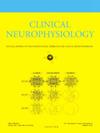前兆,而不是前兆,大脑状态的特点是全局临界减缓和局部伽马功率增加
IF 3.7
3区 医学
Q1 CLINICAL NEUROLOGY
引用次数: 0
摘要
目的对癫痫的术前评价依赖于自发发作的电生理记录。在此期间,药物剂量的减少增加了癫痫发作的可能性,使大脑从低癫痫发作可能性状态过渡到高癫痫发作可能性状态,即所谓的前癫痫状态。本研究旨在从29例药物难治性颞叶癫痫患者的386段10分钟颅内脑电图记录中确定这种转变的动态脑变化特征。方法通过平均锁相值、伽马波段相对功率和自相关函数宽度研究脑动力学。我们进一步探讨了与前周期因素的相互作用,如间隔尖峰和高频振荡的频率、昼夜节律和多日周期以及临床结果。结果:我们观察到在致痫区伽马能量显著增加,而在致痫区和可能健康的皮层都出现了严重的减慢。这些变化与尖峰和高频振荡速率的增加有关。结论从开始到结束的多天间隔,脑动力学在慢时间尺度上发生变化,而在前兆间隔的短期内没有变化,因此可以反映前兆变化。我们强调了伽马功率和临界慢化指数作为癫痫前脑状态的标志物,以及它们在癫痫患者术前评估中追踪癫痫相关脑机制的潜力。本文章由计算机程序翻译,如有差异,请以英文原文为准。
Pro-ictal, rather than pre-ictal, brain state marked by global critical slowing and local gamma power increase
Objective
The pre-surgical evaluation of epilepsy relies on the electrophysiological recordings of spontaneous seizures. During this period drug dose decreases increase the likelihood of seizures transitioning the brain from a low to high seizure likelihood state, so-called pro-ictal state. This study aimed to identify the dynamic brain changes characteristic of this transition from 386 ten-minute segments of intracranial EEG recordings of 29 patients with drug-refractory temporal lobe epilepsy.
Methods
We studied brain dynamics through mean phase locking value and relative power in gamma band, and autocorrelation function width. We further explored interactions with pro-ictal factors, such as rate of interictal spikes and high frequency oscillations, circadian and multi-day cycles, and clinical outcomes.
Results
We observed significant increases in gamma power in the epileptogenic zone, and critical slowing in both the epileptogenic zone and presumably healthy cortex. These changes were linked with increases in spike and high frequency oscillations rate.
Conclusions
Brain dynamics changed on the slow time scale – from the beginning to the end of the multi-day interval – but did not change in the short-term during the pre-ictal interval, thus could reflect pro-ictal changes.
Significance
We highlight gamma power and critical slowing indices as markers of pro-ictal brain states, as well as their potential to track the seizure-related brain mechanisms during the presurgical evaluation of epilepsy patients.
求助全文
通过发布文献求助,成功后即可免费获取论文全文。
去求助
来源期刊

Clinical Neurophysiology
医学-临床神经学
CiteScore
8.70
自引率
6.40%
发文量
932
审稿时长
59 days
期刊介绍:
As of January 1999, The journal Electroencephalography and Clinical Neurophysiology, and its two sections Electromyography and Motor Control and Evoked Potentials have amalgamated to become this journal - Clinical Neurophysiology.
Clinical Neurophysiology is the official journal of the International Federation of Clinical Neurophysiology, the Brazilian Society of Clinical Neurophysiology, the Czech Society of Clinical Neurophysiology, the Italian Clinical Neurophysiology Society and the International Society of Intraoperative Neurophysiology.The journal is dedicated to fostering research and disseminating information on all aspects of both normal and abnormal functioning of the nervous system. The key aim of the publication is to disseminate scholarly reports on the pathophysiology underlying diseases of the central and peripheral nervous system of human patients. Clinical trials that use neurophysiological measures to document change are encouraged, as are manuscripts reporting data on integrated neuroimaging of central nervous function including, but not limited to, functional MRI, MEG, EEG, PET and other neuroimaging modalities.
 求助内容:
求助内容: 应助结果提醒方式:
应助结果提醒方式:


